Seok-Bae Yun
Separable Physics-informed Neural Networks for Solving the BGK Model of the Boltzmann Equation
Mar 10, 2024Abstract:In this study, we introduce a method based on Separable Physics-Informed Neural Networks (SPINNs) for effectively solving the BGK model of the Boltzmann equation. While the mesh-free nature of PINNs offers significant advantages in handling high-dimensional partial differential equations (PDEs), challenges arise when applying quadrature rules for accurate integral evaluation in the BGK operator, which can compromise the mesh-free benefit and increase computational costs. To address this, we leverage the canonical polyadic decomposition structure of SPINNs and the linear nature of moment calculation, achieving a substantial reduction in computational expense for quadrature rule application. The multi-scale nature of the particle density function poses difficulties in precisely approximating macroscopic moments using neural networks. To improve SPINN training, we introduce the integration of Gaussian functions into SPINNs, coupled with a relative loss approach. This modification enables SPINNs to decay as rapidly as Maxwellian distributions, thereby enhancing the accuracy of macroscopic moment approximations. The relative loss design further ensures that both large and small-scale features are effectively captured by the SPINNs. The efficacy of our approach is demonstrated through a series of five numerical experiments, including the solution to a challenging 3D Riemann problem. These results highlight the potential of our novel method in efficiently and accurately addressing complex challenges in computational physics.
Separable Physics-Informed Neural Networks
Jul 03, 2023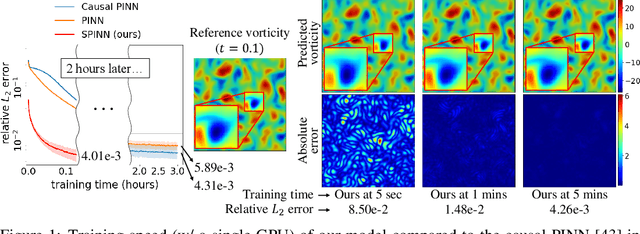
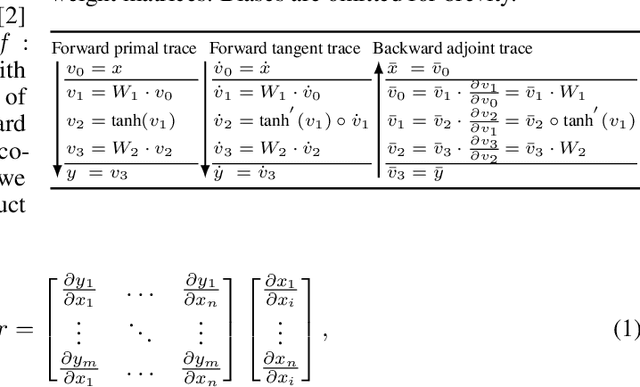

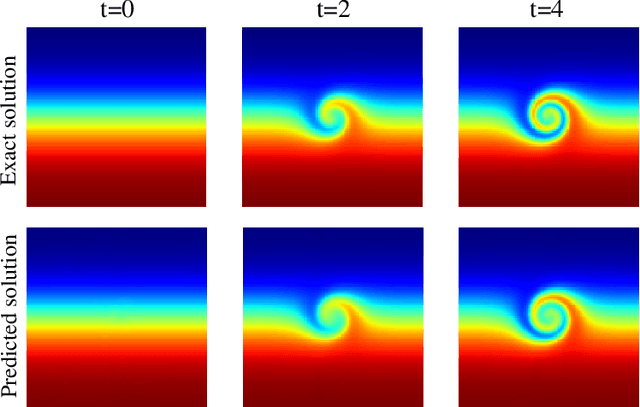
Abstract:Physics-informed neural networks (PINNs) have recently emerged as promising data-driven PDE solvers showing encouraging results on various PDEs. However, there is a fundamental limitation of training PINNs to solve multi-dimensional PDEs and approximate highly complex solution functions. The number of training points (collocation points) required on these challenging PDEs grows substantially, but it is severely limited due to the expensive computational costs and heavy memory overhead. To overcome this issue, we propose a network architecture and training algorithm for PINNs. The proposed method, separable PINN (SPINN), operates on a per-axis basis to significantly reduce the number of network propagations in multi-dimensional PDEs unlike point-wise processing in conventional PINNs. We also propose using forward-mode automatic differentiation to reduce the computational cost of computing PDE residuals, enabling a large number of collocation points (>10^7) on a single commodity GPU. The experimental results show drastically reduced computational costs (62x in wall-clock time, 1,394x in FLOPs given the same number of collocation points) in multi-dimensional PDEs while achieving better accuracy. Furthermore, we present that SPINN can solve a chaotic (2+1)-d Navier-Stokes equation significantly faster than the best-performing prior method (9 minutes vs 10 hours in a single GPU), maintaining accuracy. Finally, we showcase that SPINN can accurately obtain the solution of a highly nonlinear and multi-dimensional PDE, a (3+1)-d Navier-Stokes equation. For visualized results and code, please see https://jwcho5576.github.io/spinn.github.io/.
On the convergence result of the gradient-push algorithm on directed graphs with constant stepsize
Feb 17, 2023Abstract:Gradient-push algorithm has been widely used for decentralized optimization problems when the connectivity network is a direct graph. This paper shows that the gradient-push algorithm with stepsize $\alpha>0$ converges exponentially fast to an $O(\alpha)$-neighborhood of the optimizer under the assumption that each cost is smooth and the total cost is strongly convex. Numerical experiments are provided to support the theoretical convergence results.
Separable PINN: Mitigating the Curse of Dimensionality in Physics-Informed Neural Networks
Nov 21, 2022Abstract:Physics-informed neural networks (PINNs) have emerged as new data-driven PDE solvers for both forward and inverse problems. While promising, the expensive computational costs to obtain solutions often restrict their broader applicability. We demonstrate that the computations in automatic differentiation (AD) can be significantly reduced by leveraging forward-mode AD when training PINN. However, a naive application of forward-mode AD to conventional PINNs results in higher computation, losing its practical benefit. Therefore, we propose a network architecture, called separable PINN (SPINN), which can facilitate forward-mode AD for more efficient computation. SPINN operates on a per-axis basis instead of point-wise processing in conventional PINNs, decreasing the number of network forward passes. Besides, while the computation and memory costs of standard PINNs grow exponentially along with the grid resolution, that of our model is remarkably less susceptible, mitigating the curse of dimensionality. We demonstrate the effectiveness of our model in various PDE systems by significantly reducing the training run-time while achieving comparable accuracy. Project page: https://jwcho5576.github.io/spinn/
Convergence analysis of unsupervised Legendre-Galerkin neural networks for linear second-order elliptic PDEs
Nov 16, 2022Abstract:In this paper, we perform the convergence analysis of unsupervised Legendre--Galerkin neural networks (ULGNet), a deep-learning-based numerical method for solving partial differential equations (PDEs). Unlike existing deep learning-based numerical methods for PDEs, the ULGNet expresses the solution as a spectral expansion with respect to the Legendre basis and predicts the coefficients with deep neural networks by solving a variational residual minimization problem. Since the corresponding loss function is equivalent to the residual induced by the linear algebraic system depending on the choice of basis functions, we prove that the minimizer of the discrete loss function converges to the weak solution of the PDEs. Numerical evidence will also be provided to support the theoretical result. Key technical tools include the variant of the universal approximation theorem for bounded neural networks, the analysis of the stiffness and mass matrices, and the uniform law of large numbers in terms of the Rademacher complexity.
PIXEL: Physics-Informed Cell Representations for Fast and Accurate PDE Solvers
Jul 26, 2022

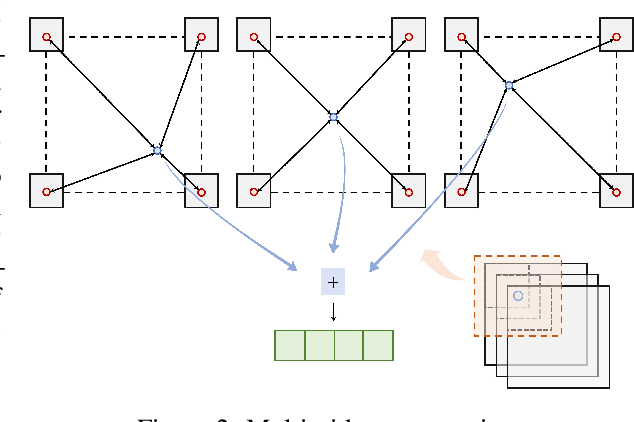
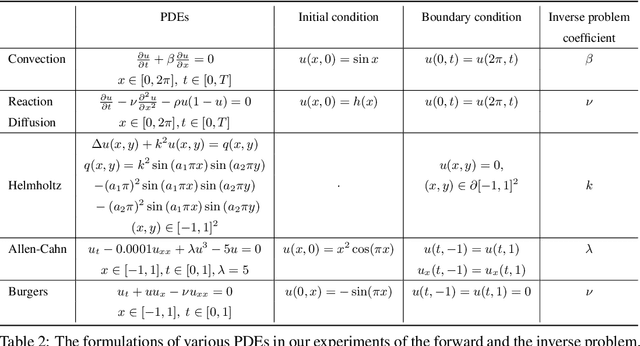
Abstract:With the increases in computational power and advances in machine learning, data-driven learning-based methods have gained significant attention in solving PDEs. Physics-informed neural networks (PINNs) have recently emerged and succeeded in various forward and inverse PDEs problems thanks to their excellent properties, such as flexibility, mesh-free solutions, and unsupervised training. However, their slower convergence speed and relatively inaccurate solutions often limit their broader applicability in many science and engineering domains. This paper proposes a new kind of data-driven PDEs solver, physics-informed cell representations (PIXEL), elegantly combining classical numerical methods and learning-based approaches. We adopt a grid structure from the numerical methods to improve accuracy and convergence speed and overcome the spectral bias presented in PINNs. Moreover, the proposed method enjoys the same benefits in PINNs, e.g., using the same optimization frameworks to solve both forward and inverse PDE problems and readily enforcing PDE constraints with modern automatic differentiation techniques. We provide experimental results on various challenging PDEs that the original PINNs have struggled with and show that PIXEL achieves fast convergence speed and high accuracy.
 Add to Chrome
Add to Chrome Add to Firefox
Add to Firefox Add to Edge
Add to Edge